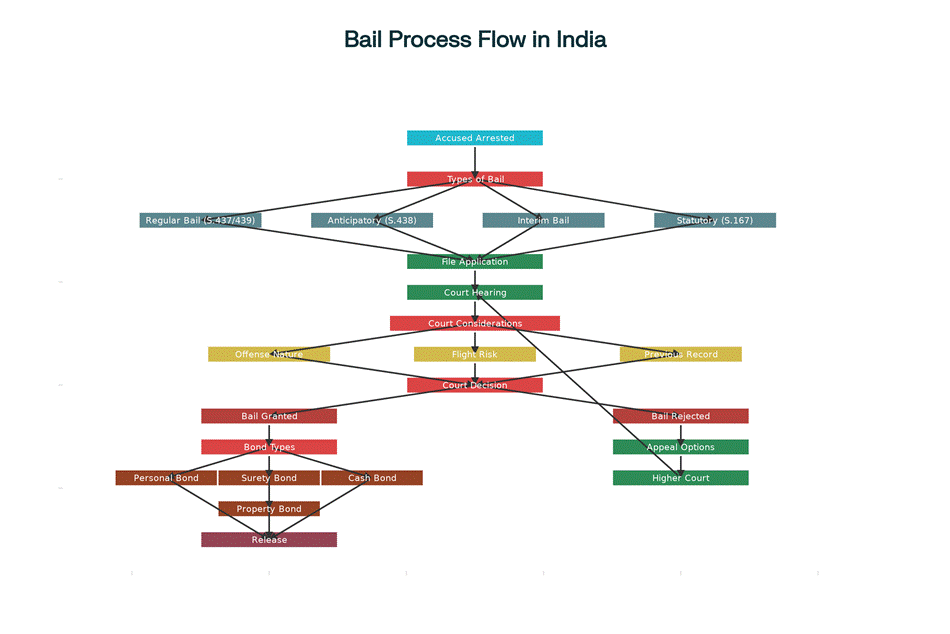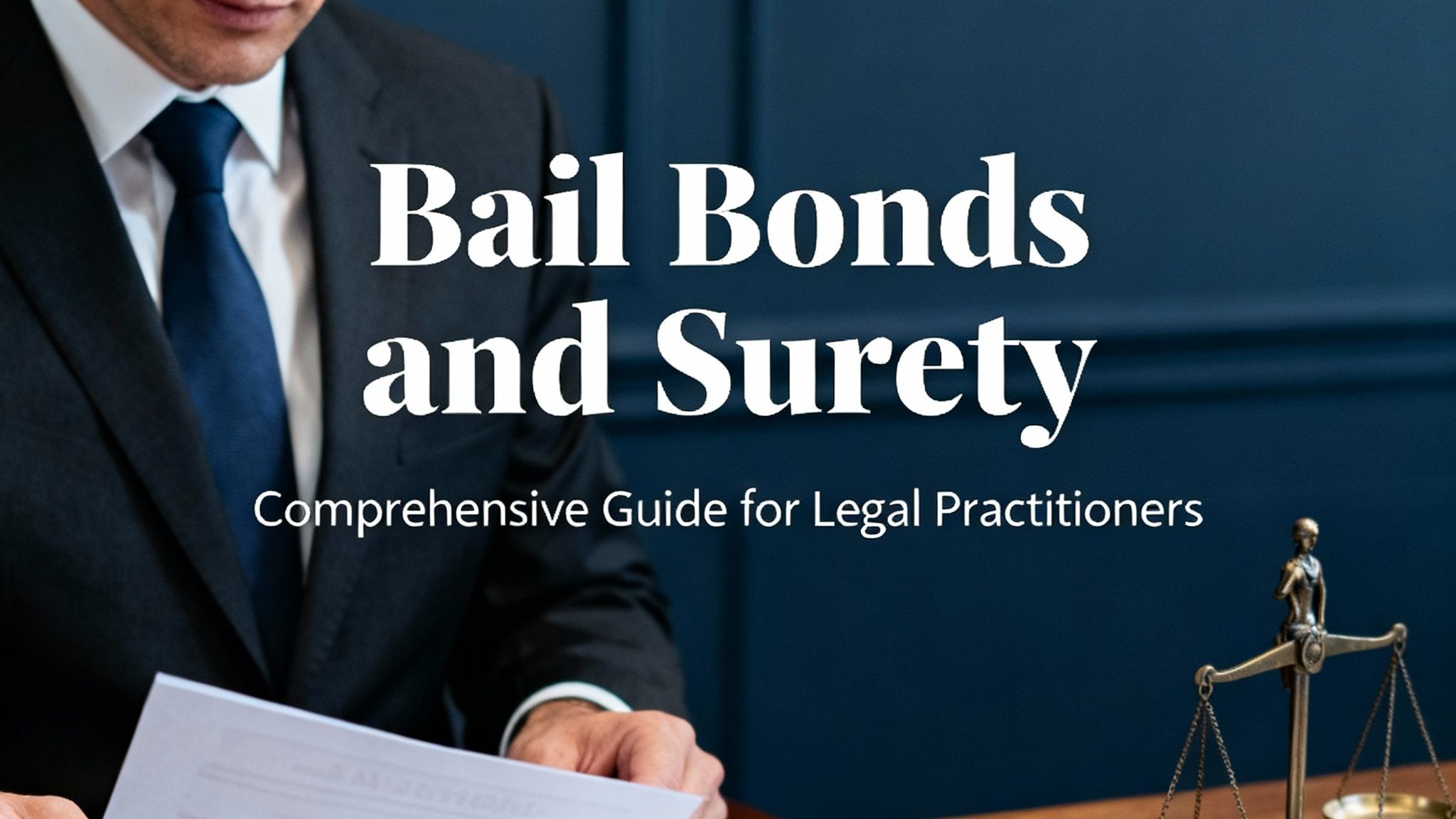Bail Bonds and Surety: A Comprehensive Guide for Legal Practitioners
The concept of bail bonds and surety represents one of the most fundamental aspects of criminal justice administration in India, serving as the primary mechanism through which the constitutional principle of personal liberty is balanced against the state’s duty to ensure justice. For legal practitioners, mastering the intricacies of bail law is essential not only for effective client representation but also for upholding the constitutional guarantee that “bail is the rule and jail is the exception”.[1][2][3]
Bail bonds function as contractual arrangements that secure temporary release from custody while ensuring the accused’s appearance for trial. This system embodies the presumption of innocence principle while providing safeguards against flight risk and potential interference with the judicial process. The surety mechanism adds another layer of security, creating a tripartite relationship between the accused, the surety, and the court that strengthens the bail system’s reliability.[4][5][6]
Understanding bail bonds and surety procedures has become increasingly critical given recent Supreme Court developments emphasizing personal liberty rights and the court’s growing concern over prolonged pre-trial detention. The evolving jurisprudence requires practitioners to stay current with both procedural requirements and strategic approaches that maximize their clients’ prospects for successful bail applications.[2][7][8]
Legal Framework and Constitutional Foundations
Constitutional Basis
The right to bail finds its foundation in Article 21 of the Indian Constitution, which guarantees the right to life and personal liberty. This constitutional provision has been interpreted expansively by the Supreme Court to include the right against arbitrary detention and the right to seek bail as a fundamental aspect of personal liberty.[1][6][2]
Article 22 further strengthens bail rights by providing protection against arbitrary arrest and detention, ensuring that no person shall be detained without being informed of the grounds for arrest and without being afforded the right to consult and be defended by a legal practitioner of their choice. These constitutional provisions form the bedrock upon which the entire bail jurisprudence is built.[6][1]
Statutory Framework Under CrPC
The Criminal Procedure Code, 1973 provides the detailed statutory framework for bail administration through Sections 436-450. The recent Bharatiya Nagarik Suraksha Sanhita (BNSS), 2023 has updated these provisions while maintaining the fundamental structure.[1][9][10][11][12]
Section 436/478 deals with bailable offenses, establishing that bail is a matter of right for such offenses and must be granted upon the accused executing a bond. Section 437/480 governs non-bailable offenses, granting discretionary power to magistrates and sessions courts to grant bail after considering various factors.[9][13][1]
Section 438/482 provides for anticipatory bail, a unique Indian innovation that allows pre-arrest protection for persons apprehending arrest in non-bailable offenses. Section 439/483 empowers High Courts and Sessions Courts with broader discretionary powers to grant bail in any case.[14][10][1][9]
Recent Legislative Changes
The BNSS 2023 has introduced several important changes while maintaining continuity with established principles:[9][10][11]
- Section 479 (previously 436A) defines maximum detention periods for undertrials
- Section 482 (previously 438) retains anticipatory bail provisions with enhanced procedural clarity
- Section 485 (previously 441) modernizes bond execution procedures
- Enhanced emphasis on time-bound disposal of bail applications

Bail process flowchart in Indian criminal law
Types of Bail and Their Applications
Regular Bail
Regular bail is granted to persons who have been arrested and are in custody, governed by Sections 437 and 439 of the CrPC. This form of bail requires demonstration that continued detention is unnecessary and that the accused will appear for trial.[1][4][15][13]
Key Considerations for Regular Bail:
- Nature of the offense: Courts assess whether the offense is bailable or non-bailable, and within non-bailable offenses, whether it falls under special statutes with stringent conditions[16][2]
- Evidence evaluation: While not conducting a mini-trial, courts consider the prima facie strength of evidence against the accused[17][16]
- Flight risk assessment: Factors include the accused’s roots in society, family ties, employment status, and previous conduct[18][19][16]
- Public safety concerns: Particularly relevant in cases involving violence, organized crime, or offenses affecting public order[16][17]
Anticipatory Bail
Anticipatory bail under Section 438 CrPC allows persons apprehending arrest to seek pre-arrest protection. This provision recognizes that false accusations and motivated prosecutions require proactive legal protection.[14][10][15]
Strategic Advantages:
- Prevents custodial interrogation: Eliminates the coercive atmosphere of police custody
- Maintains dignity: Avoids the stigma and practical consequences of arrest
- Preserves professional standing: Particularly important for professionals whose careers might be affected by arrest
- Facilitates better legal preparation: Allows consultation with counsel before facing investigation
Conditions Courts May Impose:
- Regular reporting to investigating officers
- Cooperation in investigation without obstruction
- Prohibition on leaving jurisdiction without permission
- Surrender of passport if flight risk exists
- Non-interference with witnesses or evidence[10][13][14]
Interim Bail
Interim bail provides temporary relief while applications for regular or anticipatory bail are pending. Though not explicitly provided in the CrPC, courts grant interim bail under their inherent powers to prevent injustice.[14][10][15][11]
Circumstances for Interim Bail:
- Urgent medical requirements: When the accused requires immediate medical attention
- Document procurement delays: When essential documents for bail hearing are pending
- Court schedule constraints: When regular hearing dates are distant
- Humanitarian grounds: Family emergencies or other compelling personal circumstances
Statutory/Default Bail
Statutory bail under Section 167(2) CrPC (now Section 187 BNSS) provides automatic entitlement to bail when investigation is not completed within prescribed time limits. This provision enforces the right to speedy investigation and prevents indefinite detention.[15][13][2]
Time Limits:
- 60 days: For offenses punishable with imprisonment up to 10 years
- 90 days: For offenses punishable with death, life imprisonment, or more than 10 years
- 180 days: Under special statutes like NDPS Act, UAPA, or PMLA with court extension
Understanding Bail Bonds
Types of Bonds
Personal Bond: The accused executes a bond undertaking to appear in court without requiring sureties. Courts may accept personal bonds when the accused has strong community ties and the offense is not grave.[4][5][6][13]
Surety Bond: A third party guarantees the accused’s appearance and compliance with bail conditions. The surety becomes liable for the bond amount if the accused defaults.[9][18][5][12][4]
Cash Bond: Direct deposit of the bail amount with the court, which is refunded upon case conclusion if all conditions are met. While providing maximum security, cash bonds may be financially challenging.[20][21][4]
Property Bond: Property is pledged as security for the bail amount, with the court having the power to attach and sell the property if bail conditions are violated.[18][5][22]
Bond Execution Requirements
Section 441 CrPC (Section 485 BNSS) details bond execution requirements. The bond must specify:[9][5][12]
- The amount determined by the court as reasonable and non-excessive
- Conditions for the accused’s appearance at specified times and places
- Undertakings regarding non-interference with investigation or witnesses
- Surety obligations and their liability limits
- Consequences of violation or non-compliance[5][12][9]
Essential Bond Components:
- Accused’s undertaking: Personal commitment to appear and comply with conditions
- Surety’s guarantee: Third-party assurance of the accused’s compliance
- Conditional obligations: Specific restrictions or requirements imposed by the court
- Forfeiture provisions: Consequences of non-compliance clearly stated
Surety Requirements and Verification
Who Can Be a Surety
Eligibility Criteria: A surety must be an Indian citizen with sufficient financial means to honor the bond amount. The surety should have a fixed place of residence and should not have adverse criminal history.[9][18][23][24]
Relationship Considerations: While sureties are often relatives or friends of the accused, courts also accept professional sureties who regularly provide bail services. However, courts maintain vigilance against professional sureties who might abuse the system.[18][23][9]
Financial Capacity Assessment: Sureties must demonstrate financial capability through income proof, property ownership, bank statements, and other evidence of assets. The Karnataka High Court has issued specific guidelines to prevent fake sureties.[19][23][18]
Documentation Requirements
Identity Verification:
- Aadhaar Card, PAN Card, Voter ID, or Passport for identity confirmation
- Recent photographs and signature specimens
- Address proof through utility bills, property documents, or government records[18][19][22]
Financial Documentation:
- Income Tax Returns for the last three years
- Bank statements showing financial transactions and balances
- Salary certificates for employed individuals
- Property ownership documents with current valuation
- Details of other financial assets and investments[19][24][18]
Legal Declarations:
- Affidavit stating financial capacity and willingness to stand surety
- Declaration under Section 441A CrPC regarding number of pending sureties
- Undertaking to produce the accused when required
- Statement regarding relationship with the accused and duration of acquaintance[9][22][24]
Verification Process
Court Verification: Courts may conduct inquiry into surety sufficiency through subordinate magistrates or accept affidavits with supporting documentation. The verification process includes:[9][12][23]
Document Authentication: Verification of submitted documents through appropriate authorities, cross-checking property records, and confirming employment details.[23][24]
Background Checks: Assessment of the surety’s criminal history, previous surety record, and general reputation in the community.[24][9][23]
Financial Assessment: Evaluation of the surety’s net worth, regular income, and ability to honor the bond commitment without financial hardship.[18][23][24]
Strategic Considerations for Legal Practitioners
Preparing Strong Bail Applications
Comprehensive Case Analysis: Successful bail applications require thorough analysis of the prosecution case, identification of weaknesses in evidence, and strategic presentation of factors favoring bail.[19][25][16]
Essential Components:
- Factual foundation: Clear narration of events with emphasis on the accused’s innocence or limited culpability
- Legal arguments: Citation of relevant precedents and statutory provisions supporting bail
- Personal circumstances: Details of the accused’s family, occupation, social status, and community ties
- Procedural challenges: Identification of any irregularities in arrest, investigation, or charge sheet preparation[16][17][19]
Supporting Documentation: A well-prepared bail application should include all relevant documents such as FIR copies, arrest memos, medical records (if applicable), character certificates, and employment proof.[25][19]
Addressing Common Rejection Grounds
Seriousness of Offense: When dealing with grave offenses, practitioners should focus on factors like insufficient evidence, procedural irregularities, or circumstances suggesting lesser culpability. Recent Supreme Court judgments emphasize that even serious charges cannot justify indefinite detention.[16][2][17][3]
Flight Risk Concerns: Address flight risk through documentation of strong community ties, family responsibilities, ongoing business or employment commitments, and voluntary cooperation with investigation. Offering additional sureties or conditions can demonstrate commitment to appearing for trial.[18][17][16]
Evidence Tampering Allegations: Counter such concerns by showing the accused’s cooperation with investigation, willingness to comply with conditions, and lack of access to key evidence or witnesses. Propose specific conditions like restriction on contacting witnesses if necessary.[17][16]
Previous Criminal Record: While adverse criminal history is a significant factor, practitioners can argue that past convictions were for different types of offenses, occurred long ago, or involved technical violations rather than serious crimes.[16][17]
Leveraging Recent Jurisprudential Developments
The Supreme Court’s 2024 judgments have significantly strengthened bail jurisprudence, providing powerful precedents for practitioners:[2][7][8]
Prolonged Incarceration Principle: Courts cannot deny bail indefinitely citing stringent statutory conditions when trials are unduly delayed. Cases like Sheikh Javed Iqbal v. State of U.P. establish that constitutional courts can grant bail despite statutory restrictions when the right to speedy trial is violated.[7][2]
Bail is Rule, Jail Exception: Recent decisions have reaffirmed that this principle applies even to special statutes like PMLA, UAPA, and NDPS Act when trials face inordinate delays. The Court in Sangram Suryavanshi v. State of Maharashtra criticized routine denial of bail by fixing arbitrary trial deadlines.[8][2]
Procedural Fairness: The Court has emphasized that bail applications should be decided promptly on merits rather than being shuttled between courts on procedural technicalities. Arvind Kejriwal v. CBI established that once a High Court takes up a bail matter substantially, it should decide on merits.[2]
Common Challenges and Solutions
Surety-Related Problems
Insufficient Sureties: When clients struggle to find adequate sureties, practitioners can:
- Seek reduction in bail amount citing financial constraints
- Request acceptance of single surety for multiple cases as established in Girish Gandhi v. State of U.P.[9]
- Propose alternative security arrangements like fixed deposits or government bonds
- Apply for personal bond if the accused has strong community ties[13][9]
Fake Surety Issues: The Karnataka High Court guidelines provide a framework to prevent fake sureties:[23]
- Ensure proper verification of identity documents
- Obtain original solvency certificates with proper authentication
- Verify the surety’s capacity through independent means
- Maintain detailed records of surety verification process[23]
Procedural Complications
Documentation Delays: When essential documents are pending, practitioners should:
- File for interim bail to prevent continued detention
- Provide undertakings to submit documents within specified timelines
- Use affidavits to bridge documentation gaps temporarily
- Request court assistance in obtaining official documents[19][25]
Court Scheduling Issues: Address delays through:
- Applications for urgent hearing citing personal liberty concerns
- Alternative remedy applications in higher courts if lower courts are unresponsive
- Interim protection applications pending regular hearing
- Coordination with court officials to expedite listing[2]
Addressing Prosecution Objections
Evidence Strength Arguments: Counter prosecution claims about strong evidence by:
- Demonstrating circumstantial nature of evidence
- Highlighting gaps in investigation
- Showing procedural violations that may affect evidence admissibility
- Arguing that evidence can be preserved without continued detention[16][17]
Public Interest Concerns: Address public safety arguments through:
- Offering stringent bail conditions
- Proposing supervised release arrangements
- Demonstrating the accused’s commitment to law-abiding behavior
- Showing minimal risk of offense repetition[17][16]
Best Practices for Practitioners
Client Counseling and Preparation
Setting Realistic Expectations: Clients should understand that bail is not automatic in non-bailable cases and that the process may involve multiple hearings and appeals. Practitioners should explain the various factors courts consider and potential timeline for resolution.[17][26]
Financial Planning: Discuss bail amount possibilities and surety arrangements early in the representation to avoid last-minute complications. Clients should be prepared for various financial scenarios and have backup surety options.[4][20]
Compliance Preparation: Educate clients about bail conditions and consequences of violations to prevent bond forfeiture or bail cancellation. Emphasize the importance of attending all court hearings and complying with investigation requirements.[27][26]
Court Presentation Strategies
Organized Documentation: Present well-indexed and paginated documents with proper translations where necessary. Courts appreciate thorough preparation and professional presentation.[19]
Balanced Arguments: Avoid over-arguing weak points while emphasizing strongest grounds for bail. Focus on constitutional principles of personal liberty balanced with legitimate state concerns.[16]
Responsive Pleading: Address likely prosecution objections preemptively and provide solutions through proposed conditions. Demonstrate awareness of court concerns and proactive approach to addressing them.[17][16]
Ongoing Case Management
Condition Compliance Monitoring: Maintain regular contact with clients to ensure bail condition compliance and address any issues promptly. Non-compliance can result in bail cancellation and re-arrest.[27][26]
Appeal Preparation: Be ready to move higher courts immediately if bail is rejected, with grounds for appeal already identified. Time is crucial in bail matters, and appellate remedies should be pursued without delay.[2][17]
Strategic Timing: Consider optimal timing for bail applications based on investigation progress, evidence availability, and court schedules. Sometimes waiting for investigation completion or charge sheet filing can strengthen the bail case.[25][16]
Conclusion
The law governing bail bonds and surety represents a critical intersection of constitutional rights, statutory procedures, and judicial discretion that requires sophisticated understanding and skilled advocacy. For legal practitioners, mastering these concepts is essential not only for effective client representation but also for upholding the fundamental principle that personal liberty cannot be arbitrarily curtailed.
Recent Supreme Court developments have strengthened the bail jurisprudence considerably, emphasizing that prolonged pre-trial detention violates constitutional guarantees and that courts must balance stringent statutory conditions against the right to speedy trial. These developments provide powerful tools for practitioners while also placing greater emphasis on professional competence in bail advocacy.[2][7][8]
The evolving landscape of bail law requires practitioners to stay current with both substantive legal principles and procedural innovations. The introduction of digital processes, enhanced verification mechanisms, and streamlined procedures under the new criminal laws presents both opportunities and challenges that require adaptive expertise.[9][10][11]
Success in bail advocacy depends upon thorough preparation, strategic thinking, and persistent advocacy combined with deep understanding of the constitutional, statutory, and jurisprudential framework governing bail. Practitioners who develop expertise in these areas while maintaining focus on fundamental principles of justice and human dignity will be best positioned to serve their clients effectively while contributing to the fair administration of criminal justice.[1][8][2]
The bail bond and surety system, properly understood and skillfully navigated, serves as a vital safeguard for individual liberty within the framework of criminal justice. As the legal landscape continues to evolve, practitioners must remain committed to both technical excellence and the broader goals of justice, ensuring that the constitutional promise of “bail is the rule, jail the exception” remains a practical reality for all citizens.[3][1][2]
- https://www.qualegalindia.com/bail-process-in-india.html
- https://www.livelaw.in/top-stories/25-notable-supreme-court-judgments-of-2024-on-bail-arrest-279154
- https://api.sci.gov.in/supremecourt/2024/14912/14912_2024_5_1501_57962_Judgement_17-Dec-2024.pdf
- https://www.legalkart.com/legal-blog/understanding-bail-bonds-how-they-work-and-what-happens-to-your-money
- https://bhattandjoshiassociates.com/bail-bonds-under-indian-criminal-law-legal-framework-procedures-and-judicial-interpretations/
- https://www.advdharmendraassociates.in/post/understanding-bail-bond-in-india-purpose-process-and-implications
- https://www.scobserver.in/journal/supreme-court-review-2024-batting-for-bail-in-the-face-of-delayed-trial/
- https://www.scobserver.in/journal/supreme-court-review-top-10-judgements-of-2024/
- https://www.drishtijudiciary.com/editorial/bail-sureties
- https://advocaterohitdandriyal.com/difference-between-interim-bail-anticipatory-bail-and-regular-bail-under-the-new-law-criminal-law-bnss-advocate-rohit-dandriyal/
- https://corporategenie.in/understanding-the-types-of-bail-under-the-bnss-2023/
- https://devgan.in/crpc/chapter_33.php
- https://delhi-lawyers.in/types-bail-india-and-their-conditions
- https://thelegalschool.in/blog/difference-between-interim-bail-and-anticipatory-bail
- https://blog.ipleaders.in/types-of-bail/
- https://www.advdharmendraassociates.in/post/grounds-for-rejection-of-bail-common-reasons-and-how-to-avoid-them
- https://restthecase.com/knowledge-bank/what-to-do-if-bail-is-rejected-in-sessions-court-in-india
- https://lawrato.com/criminal-legal-advice/who-can-be-a-surety-for-requesting-a-bail-242153
- https://jsrohilla.in/what-documents-are-required-for-filing-a-bail-application-in-high-court/
- https://delcobailbonds.com/surety-bond-vs-cash-bail/
- https://www.dennisblackwellbailbonds.com/the-differences-between-cash-bail-and-bail-bonds/
- https://www.scribd.com/document/814361895/SURETY-APPLICATION
- https://www.scconline.com/blog/post/2022/10/13/karnataka-high-court-issue-guidelines-prevention-fake-sureties-bail-solvency-certificate-aadhar-card-legal-news-and-updates/
- https://www.jsrohilla.com/bail-lawyer-in-indore-surety-bail/
- https://www.zolvit.com/blog/case-study/criminal-bail-application-process-documentation/
- https://www.zolvit.com/blog/bail-criminal-procedure-lawyers-assistance/
- https://www.metalegal.in/post/beyond-the-basics-a-comprehensive-guide-to-bail-cancellation-jurisdiction-grounds-and-proof
- https://highcourtchd.gov.in/sub_pages/left_menu/Rules_orders/high_court_rules/vol-III-pdf/chap10.pdf
- https://devgan.in/crpc/section/441/
- https://ksandk.com/regulatory/5-kinds-of-bail-in-india-categories-impacts/
- https://ecourts.gov.in/ecourts_home/forms/Form No 45 Bail Bond_0.pdf
- https://www.indiacode.nic.in/show-data?actid=AC_CEN_5_23_000010_197402_1517807320555&orderno=485
- https://www.instagram.com/reel/DHuzEnFveHL/
- https://cdnbbsr.s3waas.gov.in/s3ec05abdeb6f575ac5c6676b747bca8d0/uploads/2024/01/2024010521.pdf
- https://ecourts.gov.in/ecourts_home/forms/Personal bail bond form.pdf
- https://lawrato.com/legal-documents/criminal-legal-forms/bail-application-format-78
- https://kolsrudlawoffices.com/different-types-of-bail-bonds/
- https://eastdelhi.dcourts.gov.in/forms/
- https://www.worldinsurance.com/blog/what-is-the-difference-between-a-cash-and-surety-bond
- https://www.scribd.com/document/411347176/1460907957-bail-Bond-Format
- https://www.eskewlaw.com/blog/surety-bond/
- https://southeastdelhi.dcourts.gov.in/forms/
- https://www.mannyhaddadlaw.com/faq-items/cash-bond-vs-surety-bond/
- https://cdnbbsr.s3waas.gov.in/s3ec0232cbf687880eb1674a07bf717761/uploads/2024/04/2024041268.pdf
- https://www.respicio.ph/commentaries/how-to-verify-bail-posting-in-a-criminal-case
- https://tasmaniantimes.com/2025/03/common-reasons-bail-gets-refused-and-how-to-avoid-them/
- https://pjtagency.com/whether-party-seeking-preliminary-permanent-injunction-obtaining-injunction-bond-necessary-part-process/
- https://mylawyersadvice.com/principles-governing-rejection-of-regular-bail-application-2-best-criminal-lawyer-advice-in-delhi-ncr/
- https://api.sci.gov.in/supremecourt/2023/28119/28119_2023_5_1502_57962_Judgement_17-Dec-2024.pdf
- https://api.sci.gov.in/supremecourt/2024/51306/51306_2024_4_1502_59838_Judgement_28-Feb-2025.pdf
- https://delhicourts.nic.in/viewdocuments/QTdPc0VsdjNtNDhWaUV3Z0x3VGVwYTU4NXVNL0hGUUVDYkVydEJFcEZJTWtCNzY4N3Y5RVE0c3VJNkVEZGZiMDNGVjRobzFmWWdtNFQ2ZldKSkJ3UXc9PQ_EQUALS__EQUALS_
- https://www.lawyered.in/legal-disrupt/articles/defining-surety-criminal-cases-provisions-and-case-laws/
- https://www.lexisnexis.co.uk/legal/guidance/grounds-for-refusing-bail
- https://api.sci.gov.in/supremecourt/2024/43191/43191_2024_5_9_57491_Judgement_25-Nov-2024.pdf

















